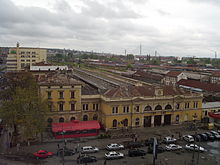Belgrade Main railway station
|
Belgrade Main Railway Station
Железничка станица Београд Главна / Železnička stanica Beograd Glavna (Serbian) |
|
|---|---|

Station building and surroundings
|
|
| Location | Savski trg 2, Belgrade |
| Owned by | Serbian Railways |
| Platforms | 6 bay platforms |
| Tracks | 13 |
| Connections | 100 m: Belgrade Bus Station |
| Construction | |
| Structure type | At-grade |
| Parking | Yes |
| History | |
| Opened | August 23, 1884 |
The Belgrade Main railway station (Serbian: Железничка станица Београд Главна / Železnička stanica Beograd Glavna) is the main intercity train station in Belgrade, the capital of Serbia. It is the busiest train station in the country and a major railway hub in the region. It was built between 1882 and 1885 after the designs of the architect Dragutin Milutinović, and it has the status of the сultural monument of great importance.
After opening of the new Belgrade Center station (Prokop) in January 2016, it was announced that the passenger trains will be gradually relocated to the new station during 2016. The Main station is expected to be closed afterwards, freeing up the space for the Belgrade Waterfront.
At the 1878 Congress of Berlin, Principality of Serbia was de jure recognized as an independent state and the great powers of the day decided that Serbia should construct the railway. Not economically developed to begin with, Serbia was additionally pauperized after the Serbian-Ottoman wars from 1876 to 1878, so it lacked the funds. Prince Milan Obrenović and the government announced the request for tender and the biding was won by a French company. Popular story goes that prince Milan took a bribe of 1 million francs in gold, in order to give the job to the French, but that was never proven.
The concession included the construction of the Belgrade–Niš railway, the train bridge over the Sava river and a railway which will connect Belgrade to Zemun, at the time, the border town of Austria-Hungary. As a location of the future station building, a marshy bog called Ciganska bara (Serbian for "Gypsy pond"). The bog was charted for the first time in an Austrian map from 1789. It was a marsh which covered a wide area from modern Karađorđeva street to the mouth of the Topčiderska Reka into the Sava, across the northern tip of Ada Ciganlija. Marshy area covered modern location of the Belgrade Main railway station and parts of the Sarajevska and Hajduk-Veljkov venac streets. Ciganska bara drained two other bogs. One was located on Slavija, which drained through the creek of Vračarski potok which flew down the area of the modern Nemanjina Street. Other pond whose water drained into the Ciganska bara was Zeleni Venac. Gypsies who lived in the area, hence the name, used the mud from the bog to make roof tiles. They lived in small huts or caravans (called "čerge"), between the high grass and rush, with their horses and water buffaloes grazing freely in the area. As most of the huts were actually stilt houses, built on piles due to the marshy land, the area was gradually named Bara Venecija ("Venice pond").
...
Wikipedia
